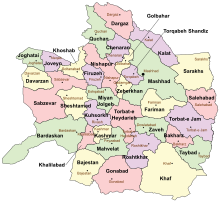Razavi Khorasan
| خراسان رضوی Razavi Khorasan
|
|
|---|---|
| Location of the Razavi-Khorasan Province in Iran | |
| Basic data | |
| Country | Iran |
| Capital | Mashhad |
| surface | 118,851 km² |
| Residents | 6,434,501 (2016 census) |
| density | 54 inhabitants per km² |
| ISO 3166-2 | IR-30 |
Coordinates: 36 ° 17 ' N , 59 ° 36' E
Razavi-Chorasan or Chorāsān-e Razawī ( Persian خراسان رضوی, DMG Ḫorāsān-e Rażavī ) is an Iranian province in the northeast of the country. The capital is Mashhad .
6,434,501 people live in the province (2016 census). The area of the province extends to 118,851 square kilometers. The population density is 54 inhabitants per square kilometer.
geography
Razavi-Khorasan is located in the northeastern part of Iran. Major cities in the province are Quchan , Dargaz , Chenaran , Sarakhs , Fariman , Torbat-e Jām , Taybad , Khaf , Rashtkhar , Kashmar , Bardaskan , Nishapur , Sabzevar , Gonabad , Kalat and Khalil Abad .
Biggest cities
The 10 largest cities in the province according to the 2016 census.
| rank | city | population |
|---|---|---|
| 1 | Mashhad | 3,001,184 |
| 2 | Nishapur | 264,375 |
| 3 | Sabsevar | 243,700 |
| 4th | Torbat-e Heydariyeh | 140.019 |
| 5 | Kashmar | 102.282 |
| 6th | Quchan | 101,604 |
| 7th | Torbat-e jam | 100,449 |
| 8th | Taybad | 56,562 |
| 9 | Chenaran | 53,879 |
| 10 | Sarakhs | 42,179 |
Administrative division
Razavi-Khorasan is divided into 28 administrative districts ( Shahrestan ):
|
|
population
Most of the province's population is Persians . In addition, around 400,000 Kurds still live here. They live mainly in the north of the province. Turkmens also make up a high percentage of the population. There are also some settled Arabs in the provincial capital . There are also large communities of refugees Afghans which, while they still have the status of refugees, but little or indistinguishable from locals up because up to 90% from the provinces of Herat , Farah and Nimruz Province originate and therefore even Chorasanier are .
After the founding of Afghanistan in the 18th century, the inhabitants of Persian descent in what is now the northern part of Khorasan , including the Afghan provinces of Herat and Farah, continued to have family, ethno-religious or economic ties to the Iranian province of Razavi-Khorasan. In the course of the Iranian refugee policy after the occupation of Afghanistan by the Soviet Union in 1979, however, from an Iranian point of view, these relations are not drawn into the focus of the previous status quo, because due to the massive refugee movement from Afghanistan to Iran since the year that followed the civil war In 1989, when the number of refugees rose to several million, the associated infrastructural and social problems in this part of Iran assumed considerable proportions that were initially difficult to manage.
history
By the year 2004 was Razavi Khorasan Province part of the former province of Khorasan .
Attractions
The province has many historical and scenic attractions such as lakes, caves, nature reserves, castles and ancient sites. There are also many important religious places such as shrines, mosques and other pilgrimage sites. According to official figures, this province, along with the other former parts of Khorasan, includes 1,179 historical and cultural sites.
Some important places are:
- Tūs , where the mausoleum of the poet Ferdousī is located
- the Gouharschad Mosque
- the tomb of Nadir Shah
- Imam Reza Shrine
- Achangan tower
- Haruniyeh Cathedral
- The citadel of Tūs
- Lake Bazangan
- Band-e-Golestan (Golestan Dam)
- Kardeh Dam
- Vakilabad and Mellat parks
- Zari, Hendelabad, Mozdooran, Moghan and Kardeh caves
- Robat Sharaf Castle
- Tombs of Khajeh Abasalt, Khajeh Morad and Ravi
- Mausoleum of Sultan Mahmud Ghaznavi
- Mausoleum of Yahya and Khajeh Rabi
- Sabz (Green) Cathedral
economy
The center of iron ore mining in Iran is located in Sangan in the south of Razavi-Khorasan .
Web links
Individual evidence
- ^ A b Thomas Brinkhoff: Iran: Administrative Division. In: www.citypopulation.de. March 19, 2017, accessed September 26, 2017 .
- ↑ Largest cities in Razavi-Khorasan. Accessed February 16, 2020 .
- ↑ cf. here
- ↑ 2 Iron Ore Pellet Plants to Come on Stream by Yearend . In: Financial Tribune . 19th September 2016.
- ↑ Jürgen Kretschmann, Ravanbakhsh Amiri: The Sangan Iron Ore Mines: A Role Model for Sustainable Development in Iran



